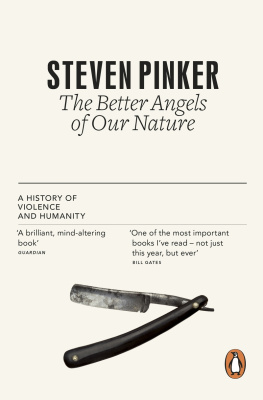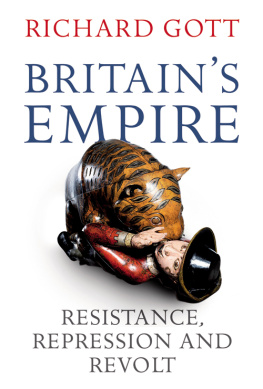Contents
What a chimera then is man! What a novelty, what a monster, what a chaos, what a contradiction, what a prodigy! Judge of all things, feeble earthworm, repository of truth, sewer of uncertainty and error, the glory and the scum of the universe.
Blaise Pascal
To
Eva, Carl, and Eric
Jack and David
Yael and Danielle
and the world they will inherit
1
A Foreign Country
The past is a foreign country: they do things differently there.
L. P. Hartley
If the past is a foreign country, it is a shockingly violent one. It is easy to forget how dangerous life used to be, how deeply brutality was once woven into the fabric of daily existence. Cultural memory pacifies the past, leaving us with pale souvenirs whose bloody origins have been bleached away. A woman donning a cross seldom reflects that this instrument of torture was a common punishment in the ancient world; nor does a person who speaks of a whipping boy ponder the old practice of flogging an innocent child in place of a misbehaving prince. We are surrounded by signs of the depravity of our ancestors way of life, but we are barely aware of them. Just as travel broadens the mind, a literal-minded tour of our cultural heritage can awaken us to how differently they did things in the past.
In a century that began with 9/11, Iraq, and Darfur, the claim that we are living in an unusually peaceful time may strike you as somewhere between hallucinatory and obscene. I know from conversations and survey data that most people refuse to believe it. In succeeding chapters I will make the case with dates and data. But first I want to soften you up by reminding you of incriminating facts about the past that you have known all along. This is not just an exercise in persuasion. Scientists often probe their conclusions with a sanity check, a sampling of real-world phenomena to reassure themselves they havent overlooked some flaw in their methods and wandered into a preposterous conclusion. The vignettes in this chapter are a sanity check on the data to come.
What follows is a tour of the foreign country called the past, from 8000 BCE to the 1970s. It is not a grand tour of the wars and atrocities that we already commemorate for their violence, but rather a series of glimpses behind deceptively familiar landmarks to remind us of the viciousness they conceal. The past, of course, is not a single country, but encompasses a vast diversity of cultures and customs. What they have in common is the shock of the old: a backdrop of violence that was endured, and often embraced, in ways that startle the sensibilities of a 21st-century Westerner.
HUMAN PREHISTORY
In 1991 two hikers stumbled upon a corpse poking out of a melting glacier in the Tyrolean Alps. Thinking that it was the victim of a skiing accident, rescue workers jackhammered the body out of the ice, damaging his thigh and his backpack in the process. Only when an archaeologist spotted a Neolithic copper ax did people realize that the man was five thousand years old.
tzi the Iceman, as he is now called, became a celebrity. He appeared on the cover of Time magazine and has been the subject of many books, documentaries, and articles. Not since Mel Brookss 2000 Year Old Man (I have more than 42,000 children and not one comes to visit me) has a kilogenarian had so much to tell us about the past. tzi lived during the crucial transition in human prehistory when agriculture was replacing hunting and gathering, and tools were first made of metal rather than stone. Together with his ax and backpack, he carried a quiver of fletched arrows, a wood-handled dagger, and an ember wrapped in bark, part of an elaborate fire-starting kit. He wore a bearskin cap with a leather chinstrap, leggings sewn from animal hide, and waterproof snowshoes made from leather and twine and insulated with grass. He had tattoos on his arthritic joints, possibly a sign of acupuncture, and carried mushrooms with medicinal properties.
Ten years after the Iceman was discovered, a team of radiologists made a startling discovery: tzi had an arrowhead embedded in his shoulder. He had not fallen in a crevasse and frozen to death, as scientists had originally surmised; he had been murdered. As his body was examined by the the CSI Neolithic team, the outlines of the crime came into view. tzi had unhealed cuts on his hands and wounds on his head and chest. DNA analyses found traces of blood from two other people on one of his arrowheads, blood from a third on his dagger, and blood from a fourth on his cape. According to one reconstruction, tzi belonged to a raiding party that clashed with a neighboring tribe. He killed a man with an arrow, retrieved it, killed another man, retrieved the arrow again, and carried a wounded comrade on his back before fending off an attack and being felled by an arrow himself.
tzi is not the only millennia-old man who became a scientific celebrity at the end of the 20th century. In 1996 spectators at a hydroplane race in Kennewick, Washington, noticed some bones poking out of a bank of the Columbia River. Archaeologists soon recovered the skeleton of a man who had lived 9,400 years ago.ever been in continuous existence for nine millennia. When the scientific studies resumed, anthropologists were intrigued to learn that Kennewick Man was anatomically very different from todays Native Americans. One report argued that he had European features; another that he matched the Ainu, the aboriginal inhabitants of Japan. Either possibility would imply that the Americas had been peopled by several independent migrations, contradicting DNA evidence suggesting that Native Americans are descendants of a single group of migrants from Siberia.
For plenty of reasons, then, Kennewick Man has become an object of fascination among the scientifically curious. And here is one more. Lodged in Kennewick Mans pelvis is a stone projectile. Though the bone had partially healed, indicating that he didnt die from the wound, the forensic evidence is unmistakable: Kennewick Man had been shot.
These are just two examples of famous prehistoric remains that have yielded grisly news about how their owners met their ends. Many visitors to the British Museum have been captivated by Lindow Man, an almost perfectly preserved two-thousand-year-old body discovered in an English peat bog in 1984. We dont know how many of his children visited him, but we do know how he died. His skull had been fractured with a blunt object; his neck had been broken by a twisted cord; and for good measure his throat had been cut. Lindow Man may have been a Druid who was ritually sacrificed in three ways to satisfy three gods. Many other bog men and women from northern Europe show signs of having been strangled, bludgeoned, stabbed, or tortured.
In a single month while researching this book, I came across two new stories about remarkably preserved human remains. One is a two-thousand-year-old skull dug out of a muddy pit in northern England. The archaeologist who was cleaning the skull felt something move, looked through the opening at the base, and saw a yellow substance inside, which turned out to be a preserved brain. Once again, the unusual state of preservation was not the only noteworthy feature about the find. The skull had been deliberately severed from the body, suggesting to the archaeologist that it was a victim of human sacrifice.








![David Schmid (editor) - Violence in American Popular Culture [2 volumes]](/uploads/posts/book/262757/thumbs/david-schmid-editor-violence-in-american.jpg)





